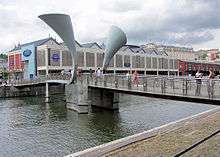Pero's Bridge
| Pero's Bridge | |
|---|---|
|
| |
| Coordinates | 51°27′00″N 2°35′52″W / 51.4501°N 2.5979°WCoordinates: 51°27′00″N 2°35′52″W / 51.4501°N 2.5979°W |
| Carries | Pedestrian |
| Crosses | St Augustine's Reach in Bristol Harbour |
| Locale | Bristol, England |
| Maintained by | Bristol City Council |
| Characteristics | |
| Design | bascule bridge |
| Longest span | 11 m (36 ft) |
| Clearance below | 3.3 m (11 ft) |
| History | |
| Opened | 1999 |
Pero's Bridge (grid reference ST585726) is a pedestrian bascule bridge that spans St Augustine's Reach in Bristol Harbour, Bristol, England. It links Queen Square and Millennium Square.
Structure
The bridge is composed of three spans; the two outer ones are fixed and the central section can be raised to provide a navigation channel in the harbour. The most distinctive features of the bridge are the pair of horn-shaped sculptures which act as counterweights for the lifting section, leading it to be commonly known as the Horned Bridge.
Pero
The bridge is named after Pero, also known as Pero Jones, who lived from around 1753 to 1798, arriving in Bristol probably from the Caribbean Island of Nevis in 1783, as the slave of the merchant John Pinney (1740–1818) at 5 Great George Street.[1][2]
History
The bridge was designed by the Irish artist Eilis O'Connell, in conjunction with Ove Arup & Partners engineers.[3] It was formally opened in 1999 by Paul Boateng MP, then a Home Office minister.[4] The name of the bridge was attacked by then Liberal Democrat councillor Stephen Williams. He condemned the decision as "gesture politics". Eilis O Connel commented "The council can call it what they want, but Pero's Bridge sounds a bit political."[5]
Dimensions

The length of the lifting span is 11 metres (36 ft) and a 9 metres (30 ft) navigation channel is provided.[6]
References
- ↑ "Pero's Bridge". History Footsteps. Retrieved 19 August 2006.
- ↑ "Bristol's Georgian House Museum". Bristol City Council. Archived from the original on 13 August 2006. Retrieved 19 August 2006.
- ↑ "Eilis O Connell Biography". Eilis O Connel sculptor. Retrieved 31 July 2013.
- ↑ Nicks, Gary (17 March 1999). "Bridge to a future of racial harmony". Western Daily Press. Retrieved 31 July 2013. (subscription required (help)).
- ↑ Onions, Ian (17 November 1998). "Slave Bridge Attack; New name a snub to city benefactor" (subscription required). Bristol Evening Post. Retrieved 31 July 2013.
- ↑ "Pero's Bridge, Bristol, UK". Arup. Archived from the original on 26 August 1998. Retrieved 19 August 2006.
Bibliography
Eickelmann, Christine; David Small (2004). PERO: The Life of a Slave in Eighteenth-Century Bristol. Redcliffe Press Ltd. ISBN 1-904537-03-0.
External links
| Wikimedia Commons has media related to Pero's Bridge. |
- 360 degree panorama of the bridge from BBC
- Bristol City Council presentation & booklet
- Pero's Bridge at Structurae